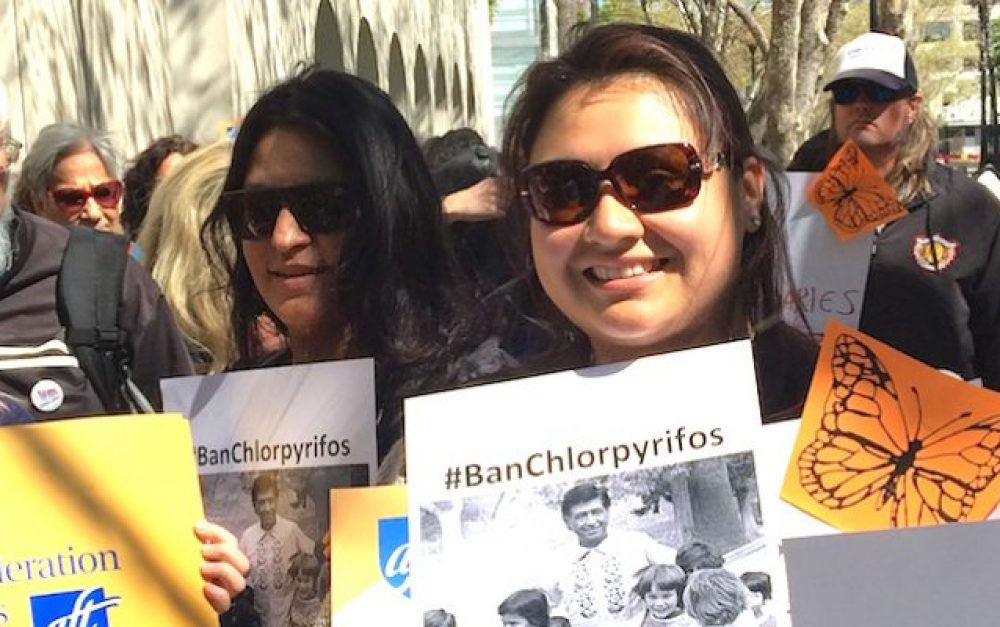For Immediate Release: March 31, 2017
Chavez Day events highlight the long struggle to end widespread use of a chemical linked to autism and IQ loss
Sacramento, CA – In the aftermath of the U.S. Environmental Protection Agency’s (EPA) failure to heed its own scientists’ advice and end the use of the brain-harming pesticide chlorpyrifos, residents of California’s farmworker communities are calling on Governor Jerry Brown to move swiftly and enact an immediate statewide ban. The body of science showing harm to human health is clear, and EPA scientists acknowledge chlorpyrifos can cause irreversible neurological and respiratory damage as well as developmental delays, autism and IQ loss — even in very small doses. The call for a statewide ban comes fittingly on Cesar Chavez Day, a day on which we honor the late co-founder of the United Farm Workers (UFW) and his legacy of leadership in the struggle against pesticide harms.
Chlorpyrifos use is particularly problematic in California, where an estimated 1.3 million pounds of the neurotoxic organophosphate pesticide are used each year. Accounting for roughly 20 percent of the nationwide total, this chemical is applied on more than 80 different crops, with almonds, walnuts, oranges, and lemons among the most heavily treated.
“Chlorpyrifos poses a serious threat to children across the state, particularly those in agricultural communities,” said Francisco Rodriguez, president of the Pajaro Valley Federation of Teachers and father of a young child. Rodriguez joined the annual convention of the California Federation of Teachers in Sacramento today. “Regulators have delayed action for too long and California must step up to defend the health and cognition of our children.”
EPA’s announcement late Wednesday that it would not implement its proposed ban comes after many years of stalling — and intense pressure from Dow Chemical, the largest manufacturer of the widely-used neurotoxic pesticide. In November, EPA announced that it intended to revoke all food tolerances of chlorpyrifos, calling it unsafe to use in any amount. Underscoring the importance of this proposed ban, the agency cited the serious dangers of chlorpyrifos and added that young children risk exposure from food residues alone that are 14,000 percent higher than the level EPA currently believes is safe. Science showing harms to children’s health, particularly their brains, is not new. EPA outlawed all home use of chlorpyrifos in 2000, almost 17 years ago, because of the same concerns.
EPA chief Scott Pruitt’s announcement of an about-face on chlorpyrifos, in defiance of the findings of his own scientists, frustrated many who had worked for years on building the case for a ban. Former EPA scientist Jim Jones, who left the agency in January when President Trump took office, commented, “They are ignoring the science that is pretty solid,” adding that he believed the ruling would put farm workers and children at unnecessary risk.
For residents of farming communities where the drift-prone organophosphate is sprayed, the announcement came as a particularly hard blow. A 2014 comprehensive study of environmental causes of autism, known as the CHARGE study, found that pregnant women who lived within a mile of fields where chlorpyrifos was sprayed more than tripled their chances of giving birth to a child with autism. Additionally, the UC Berkeley CHAMACOS team, studying organophosphate impacts on women and children in the Salinas Valley, found that every 522 pounds of combined organophosphate pesticide applications within 1 kilometer of a pregnant woman’s home correlates with a two point IQ loss in her children at seven years old.
“The science is in, and has been for some time,” said Dr. Emily Marquez, PhD, staff scientist at PAN. “Research shows that chlorpyrifos exposure before birth is sufficient to affect children’s brain development, including changes to the structure of the brain. Delaying further action to protect farmworker families and rural children is irresponsible and unfair.”
EPA faces severe cuts and regulatory rollbacks under the Trump administration, and the agency’s proposed ban of chlorpyrifos was clouded by uncertainty ever since it was announced on November 9, just one day after Trump’s election. The comment period for the proposed ban ended on January 17, and the deadline for the agency to announce its decision was set to end today, on Cesar Chavez Day. Given the federal agency’s failure to act, all eyes are now on agricultural states to step up.
Residents of California’s farming communities, for whom banning chlorpyrifos has long been a top priority, are now turning to California Governor Jerry Brown to take action. Advocates argue that the many years of rigorous, federal scientific review, and EPA’s ultimate conclusion that the pesticide is simply too dangerous to use, are more than sufficient justification for enacting an immediate statewide ban.
Citing the joint statement issued by California’s legislative leaders on the day after Trump’s election, which vowed not to “allow one election to reverse generations of progress” and pledged that California would be the keeper of the nation’s future, residents say that the hamstrung federal EPA makes California’s role in safeguarding environmental and human health protections more critical than ever.
In a letter seeking Governor Brown’s intervention, the statewide coalition Californians for Pesticide Reform (CPR) said: “We have been heartened by the stand taken by you and the California legislature to ‘lead the resistance’ to the Trump administration’s predilection to rely on alternative facts, ignore science, and eliminate regulations intended to protect the public’s health, safety and environment, and we’re asking your administration now to live up to that promise and implement EPA’s proposed chlorpyrifos ban on food uses in California.”
Today, UFW and advocates across the state, including in Fresno, Porterville, and Salinas are adding their voices to the coalition’s appeal, calling on California to act swiftly in enacting its own ban. “It’s my hope that our Governor will follow through on his promise to lead when the feds fail us,” said Lucia Calderon, coordinator of the Safe Ag Safe Schools coalition in Monterey and Santa Cruz Counties.
Cesar Chavez’s last and longest fast, 36 days in 1988, was a protest against pesticides that specifically called for the banning of five chemicals — two of them organophosphates like chlorpyrifos. Chavez said a year later, “If we ignored pesticide poisoning, if we looked on as farm workers and their children are stricken, then all the other injustices our people face would be compounded by an even more deadly tyranny.”
###
Contact: Paul Towers, 916-216-1082, ptowers@panna.org
Californians for Pesticide Reform (CPR) is a statewide coalition of more than 190 organizations, founded in 1996 to fundamentally shift the way pesticides are used in California. CPR’s mission is to protect public health, improve environmental quality and expand a sustainable and just agriculture system by building a diverse movement across California to change statewide and local pesticide policies and practices.
Headquartered in California, Pesticide Action Network (PAN) North America is one of five regional centers worldwide that represents a coalition of 600 public interest organizations in more than 90 countries. PAN challenges the global proliferation of pesticides, defends basic rights to health and environmental quality, and works to ensure the transition to a just and viable food system.







